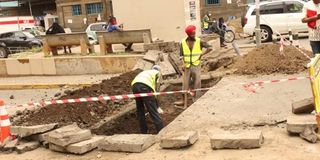With city status, Nakuru sees upsurge in building activities

Workers building pedestrian walkways within the Nakuru's CBD. Following its elevation to a city, Nakuru is witnessing an upsurge in building activities.
A new visitor to Nakuru, recently elevated to a city, will notice that it is a huge construction site.
Everywhere you turn, a road is being built, a drainage system revamped or a pavement laid out.
The historic Afraha Stadium is being refurbished and pedestrian walkways set up in the city centre under the non-motorised transport programme.
The developments come a month after President Uhuru Kenyatta on December 1 awarded a charter to the Nakuru municipality, making it officially a city after years of lobbying.
Nakuru officially joined Nairobi, Mombasa and Kisumu in the ranks of cities.
The upsurge in building activities now means that contractors must divert traffic or accommodate motorists as construction goes on.
The huge mounds of soil on the blocked roads have led to traffic jams.
Afraha Stadium upgrade
To the east of the city, renovations of the historic Afraha Stadium to international standards is underway.
The Sh650 million project kicked off six months ago.
The ambitious upgrade, which will see the 5,000-seater stadium house all sporting disciplines and a convention centre, will be done in phases over five years.
Once completed, the stadium will spruce up the face of Nakuru, becoming the main stadium in the city.
The 60-year-old stadium, in Nakuru East sub-county, was in a deplorable condition.
The developments are meant to spruce up the face of Nakuru and make it a world-class city, said City Manager Gitau Thabanja.
"We have embarked on construction works to improve the drainage, revamp the road infrastructure, introduce pedestrian walkways, streamline garbage disposal, address the housing challenge, street lighting, traffic jams, introduce eco-friendly amenities among other things key to city status,” Mr Thabanja said.
Traffic jams
He added that the pain of traffic jams and inconveniences caused by the construction works will be short-term.
The most affected is Kenyatta Avenue, Nakuru's main street.
Here, city authorities are building pedestrian walkways and revamping the drainage system.
Nakuru County has allocated Sh80.7 million for building the walkways in the city centre.
The first phase of the 750-metre stretch on Kenyatta Avenue will be completed in seven months and will run from the Shik Park building to KCB Bank on both sides of the street and then Moi Road to Oginga Odinga Lane, next to the county headquarters.
Phase two will start from KCB to Westside Mall and then link to Oginga Odinga Road.
Governor Lee Kinyanjui has revealed that the 22-metre-wide road on the left side will have a four-metre pedestrian walkway, a 1.5-metre green space that will include street lighting and drainage, and a 2.25-metre parallel parking for essential services such as security, loading and unloading.
Better services
"The elevation of Nakuru to a city means Nakuru residents must get better services. My administration is expected to improve the planning of the town, streamline garbage disposal, address the housing challenge, street lighting, roads and infrastructure, and traffic jams, among other things,” Mr Kinyanjui told the Nation in an interview.
“We want to introduce pedestrian walkways starting with the central business district.
"They (walkways) will be extended to other areas. They will not only offer safety to pedestrians but also contribute to decongestion on the roads.”
The money for the walkways is from funds meant for urban development in the new city under the Kenya Urban Support Programme (KUSP), which is supported by the World Bank.
The funds will also be used to improve drainage and urban planning, and instal CCTV cameras.
Upgrade slums
Governor Kinyanjui said his administration, with development partners including the World Bank, have also kicked off plans to upgrade the town’s slums.
“We laud the World Bank for the programme, which will have a major transformative impact on informal settlements,” he said.
“The initiative, besides slum upgrading, will also target improvement of drainage infrastructure, waste management, improvement of roads in the slums and installation of lights.”
The targeted slums include Kaptembwo, the largest in the city with more than 100,000 residents.
Others are Kivumbini, Lake View, Kwa Rhonda, Flamingo, Kaloleni and Bondeni.
Last week, administrators also directed owners of buildings to upgrade and repaint them and ensure they are well maintained as part of the ongoing beautification project.
The directive could also see old structures, especially in the city centre, revamped to pave the way for modern buildings, according to a source in the county government.
Paint buildings
In a January 20 notice from Mr Thabanja, owners of buildings are required to paint them and ensure they are well maintained, including fixing gutters and removing obstructive materials such as billboards, placards and posters on walkways to ensure safe and free movement.
"All building owners are also expected to ensure proper disposal of garbage from their premises and that none finds its way into designated public spaces,” the notice said.
“Persons with illegal developments such as kiosks and car washes on road reserves will be required to relocate to formally designated and user compatible areas and those not in compliance (will be) removed within a hundred days."
All taxi, motorcycle and tuktuk owners have been ordered to ensure their vehicles operate from designated pickup areas.
Hawkers and street vendors, especially those operating on the highway, Kenyatta Avenue and East Road, are required to relocate to designated markets while drivers should park in designated spaces and not on pedestrian walkways and pavements.
The city’s matatus and hawkers have been relocated from the central business district.
In 2015, the governor at the time, Kinuthia Mbugua, successfully relocated hawkers from the CBD in a bid to decongest the city.





